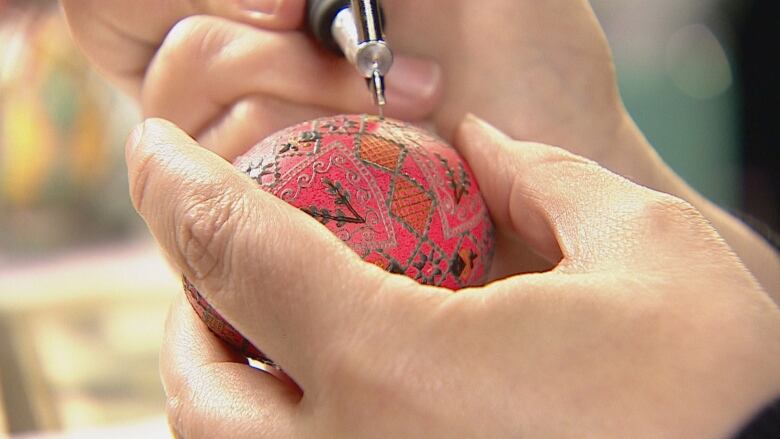Calgary artist connects with Ukrainian culture by making dozens of intricate Easter eggs
Cathy Reitz, a pysanka artist, createsintricate designs on the fragile shells
A Calgary artist is busy passing down a centuries-old tradition for Easter this year.
Cathy Reitzsays pysanka from the Ukrainian verb pysanty, meaning "to write" is the practiceof creatingintricate Ukrainian Easter eggs.
WATCH | See how much detail goes into each egg in the video above
"My great aunt taught me she was taught by her mother before, and her mother before that," she said.
"It was such a deep, meaningful tradition to do at Easter."
Now, shemakes almost 50 pysanky eggs every year, witheach requiring hours ofcreativity and patience.

"To be able to do it here in Calgary is really special, and it's really meaningful. And I'm just one of quite a few in Calgary that are actively keeping up the tradition of pysanka writing."
How it works
The eggs may look like a fun Easter craft, but inReitz's case it can take five to nine hours to complete one egg.
"You can see all the hard work, all the hours you put in, and see how it translated," she said.
First, she starts by ensuringall the insides of the egg are completelyremoved.
"It is very heartbreaking after spending hours on a design, when you go to hollow it out afterwards, taking the insides out, and it cracks on you and you're left with a mess," she said.

Once the shells are treated and each egg is blown out, she's ready to start drawing; however, the artist warns a lot of patience is needed during this process.
"In between each layer, you then have a new colour. And you can't start right away. You need to wait for the process, for the colour to dry, before you're able to keep on writing."
While most designs follow Ukraine tradition, Reitz says each symbol has a meaning and sometimes a special wish.
"I have one that I'm doing right now that is for a friend who lost her house before Christmas in a house fire. And it is filled with symbolism of protection, new beginnings, good wishes for the future," she explained.
History of UkrainianEaster
Ukrainians around the world still gather to write pysanky during Orthodox Easter, which will land on May 2 this year.
But in pre-modern times, the eggs served a more functional purpose: They were thought to have magical properties.

Some were kept inside the home to guard against storms and fire; some were placed with animals to promote fertility;and a few were saved to place in the coffins of loved ones who died during the year.
- DIGITAL ARCHIVES:Pysanka Easter Egg in Vegreville, Alta.
- 'I find it very zen': The delicate art of pysanky, an enduring Ukrainian Easter tradition
It was traditionally done every Easter by the women in Ukrainian families and was not supposed to be attempted by children.
However, theworldwide practicenow has a dedicated museum to the art of pysankain the Ukrainian city ofKolomyia.
Reitzsays she has sent one of her own eggs to be featured at the museum.
"Now that I've been able to send one, I actually truly feel like a piece of me is out there to help represent my family, represent their history and have a little piece of my art out there," she said.
With files from James Young and Althea Manasan.













_(720p).jpg)


 OFFICIAL HD MUSIC VIDEO.jpg)
.jpg)



























































































